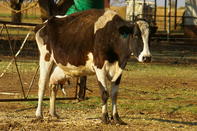
Metabolic diseases in dairy cows are not contagious and are usually the result of poor nutrition management. It is most likely to occur around the time of calving, but most metabolic diseases can be prevented by good nutritional management.
Milk Fever Symptoms in Dairy Cows

Milk fever in dairy cows usually occurs at calving or 3 to 4 days after calving in older, high producing cows. It is also more common in Jerseys than other breeds. Milk fever is caused by a sudden decline in blood calcium (Ca) levels because of the production of milk.
During the dry period, dairy cows have low calcium requirements. At calving and shortly after, a cow’s calcium requirements increase quickly because of the production of milk. If feed intake of calcium is also low, calcium is released from the skeleton.
When this process is slow, hypocalcemia (milk fever) develops. It is also called downer cow syndrome as cows experience muscle failure, which cause them to lie down.
There are three distinct stages in milk fever: Firstly, affected cows show signs of hypersensitivity, nervousness, ears twitching and lying down. Secondly, cows lie down in a sternal position, with its head into its flank.
Thirdly, the cows lie down in a lateral position and show no response to stimuli, become unconscious, which then leads to death. Early treatment involves an intravenous Ca injection. Preventative measures are aimed at dry cow feeding.
Bloat in Dairy Cows
Bloat in dairy cows is caused by an excessive accumulation of gas in the rumen of cows. Usually, this gas is belched away. Bloat often occurs when cows graze legume pastures, such as clover and lucerne in spring. Hungry cows gorging themselves on young pasture are also at risk. Mornings with dew on the grass or overcast, windy days are also associated with outbreaks.
Bloat can be prevented by feeding hay or silage before cows go out to the pasture. Alternatively, cows should have access to pasture for a short period, say one to two hours only. Drenching cows after milking with a detergent in the mouth is used widely in pasture-based systems in New-Zealand.
Alternatively, more roughage can be added to the diet. Once cows are bloated and in severe distress, the gas should be released by using a trocar (special three-sided needle) or a wide bore milk fever needle.
The site for the stabbing is on the left flank, an open hand's width behind the last rib and a similar distance below the ends of the short ribs. A veterinarian should close the cut and administer antibiotic treatment to prevent further complications.
Acidosis
Acidosis in dairy cows is caused by cows consuming diets low in physically active fibre (roughage) and high in rapidly fermentable carbohydrates such as maize, wheat or barley. The acidity level of the rumen fluid fluctuates during a 24-hour period. Acidosis occurs when acidity levels are high, at pH values below 5.5. This happens when the diet has high levels of easily fermentable carbohydrates (in concentrates) and a lack of physically active fibre, roughage.
Because of this, rumination (chewing the cud) is reduced, which in turn will lead to a reduced natural buffering capacity of the rumen. During rumination natural buffering occurs from the saliva being swallowed. To prevent acidosis, limit the intake of concentrate and include long-fibre particles in the diet.
Long fibre in the diet encourages rumination after feeding. Including a commercial dietary buffer like sodium bicarbonate (baking soda) in the food when a lot of concentrate are fed, can also reduce rumen acidity levels.